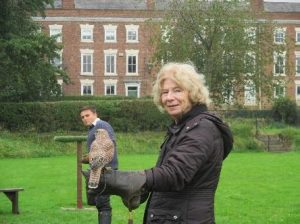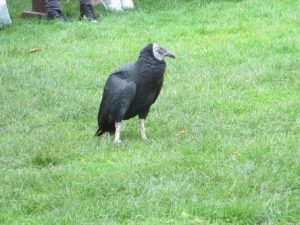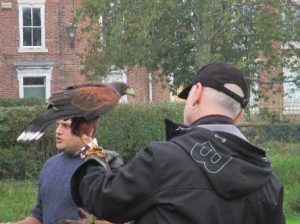No. 562 January 2018 Edited by Sue Willetts
HADAS Diary
Tuesday 9th January 8pm: Prof. Christopher Scull. The Anglo-Saxon princely burial at Prittlewell, Essex.
Tuesday 13th February at 8pm: Dr Matthew Symonds. ‘Protecting the Roman Empire: understanding fortlets and frontiers’.
Tuesday 13th March at 8pm: Roman London’s First Voices: Roman writing-tablets from Bloomberg, London. Lecture by Dr Roger Tomlin.
All Lectures are held at Stephens House & Gardens (Avenue House), 17 East End Road, Finchley, N3 3QE, and start promptly at 8.00 pm, with coffee & tea served afterwards. Non-members welcome (£2.00). Buses 13, 125, 143, 326 & 460 pass nearby and Finchley Central Station (Northern line) is a 5-10-minute walk away.
Information on the January lecture: The Prittlewell Prince: life, death and belief in south-east England at the time of St Augustine
The outstanding Anglo-Saxon burial at Prittlewell, Southend, Essex was discovered and excavated in the winter of 2003-2004 by a team from Museum of London Archaeology. The importance of the well-preserved chamber grave and its outstanding assemblage of grave goods, dating from c AD 600, was immediately apparent and prompted international academic and public interest. A full programme of study and analysis has now been completed and a full report is in preparation for publication in 2018. This lecture will review what we now know about of the chamber grave and the individual buried there, and how this changes our understanding of the early East Saxon kingdom and its place in south-east England at the dawn of English Christianity.
Christopher Scull is academic advisor to the Prittlewell project and a joint author, with Lyn Blackmore, Ian Blair and Sue Hirst, of the forthcoming monograph report. A Visiting Professor at the Institute of Archaeology, University College London, and the Department of Archaeology and Conservation, Cardiff University, he is a former Research Director of English Heritage and has published widely on the archaeology of Anglo-Saxon England.
Hadas Christmas Party Jim Nelhams
What a lovely response to our Christmas Party this year. Forty-seven people planned to attend, but nobody was dreaming of a “White Christmas Party” to make travel so difficult. Twenty-six people managed to get to Avenue House to enjoy the splendid dinner cooked by
the Avenue House staff, one of whom had walked from Whetstone. Some of our attendees had similar tales of their journey. Well done to all that made it and commiserations to those snowbound at home.
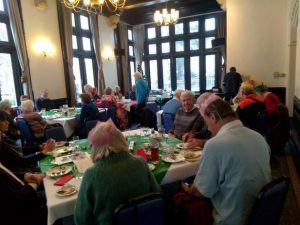
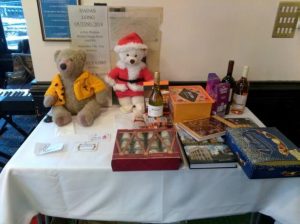
Thanks to Melvyn for the photos.
What did they miss? Most of all, the good company of all that were there, with the day compèred by Don Cooper sporting this year’s Christmas Jumper, complete with flashing lights. Musical entertainment came from Jim and Jo Nelhams with everybody joining in some Christmassy songs, and the intellectual challenge in the form of a table quiz came from Vicki Baldwin, who was unfortunately herself under the weather! Two wonderful cakes had been cooked by Liz, and slices of these were duly consumed with coffee and mince pies. And, of course, the raffle with the star prize of a bottle of Roman wine, carefully guarded by Ted, our mascot, and his friend.
Nice to see our President, Harvey Sheldon, who travelled up from his home in South London, where there was no snow.
Summer Trip 2018 Jim Nelhams
Already we have had 30 people express an interest in the trip, which is sufficient to go ahead. We will be using the Best Western Brome Grange Hotel, near Diss. This hotel is slightly smaller than most of our previous destinations, with only 40 rooms, of which we have reserved 30, so if you want to come, please let Jo or myself know. Contact information is at the end of this newsletter.
The price depends partly on the numbers sharing the coach but is expected to be £530 for a single room, or £480 per person sharing a room, and increase of £5 over last year. Deposits will be required at the end of February. The trip itself is from Monday 17th to Friday 21st September (inclusive).
So do not miss out by delaying. If we know early enough, we may be able to reserve the odd extra room.
Jodrell Bank / Heritage
Further to the item in the November newsletter, Peter Pickering spotted this item in the Budget statement
4.60 Jodrell Bank – The government is providing £4 million to Jodrell Bank, subject to approval of a sustainable business case, as part of their £20.5 million project to create a new interpretation centre promoting the historically significant scientific work undertaken at this site in Cheshire. The following is the link to Heritage Alliance’s preliminary note on the budget and how it might impact on the Heritage. Budget item
Frodsham Trip – Day 3 Jim Nelhams
On our trips, we have a chance to enjoy the various interests of members in the group, and they provide us with interesting and enthusiastic notes. Although we started in the Cathedral with its history and archaeology, we then had the chance to go and indulge other interests.
Chester Cathedral Simon Williams
Chester Cathedral, dedicated to St. Werburgh, was originally (from the 1190’s) a Benedictine Abbey of which only one round arch span survives in the North transept, impressive and remarkably still intact, and standing to a fair height – despite the vogue for destruction of the C16 and 17 waves of denial, ironically, only escaping due to having been dismantled. For example, that of Becket, and most others being raised to the ground.
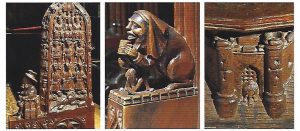
The quire contains a remarkable display of the woodcarvers’ art – misericords and bench ends such as the Pelican in her piety, an elephant bearing a fortified medieval fighting platform, the Eagles of the 4 evangelists, Jacob’s dream with an angel bearing a ladder, a Medieval pilgrim to St. Werburgh’s, complete with beard, large brimmed hat (presumably to keep out the journey’s weather?) and a staff. Victorian ones depict Aesop’s Fables.
The South Isle contains the Chester Imp, his stone frozen figure looking very uncomfortable, with head and limbs are twisted rather savagely contorted at right-angles (maybe due penance for being an imp? – I wouldn’t know!), and rather squashed into the rectangular facet of a construction stone, very much like inspiration for a C20 modernist piece? Whatever else, he is bound to see you, even if you not him! The C20 glass is a success, particularly the 1961 Great East Window.
A welcome bonus was a falconry display, initiated to act as a pigeon scarer. This enterprise has become a “decoy” attraction in its own right, and a convenient source of income. We were invited to
handle a small black Egyptian vulture and a falcon, with flights to the glove for group members. It was remarkable how fast and swooping silently low they returned super-accurately, brushing between onlookers’ heads by inches, returning for bait– that elusive free lunch? We were also shown the aviary which even contained a Golden Eagle.
Chester Cathedral Falconry and Nature Gardens Sylvia Javes
After our visit to the cathedral we were taken round to the falconry in the cathedral grounds. Several birds were on perches on the lawn, with others in aviaries around the site. There were hawks, buzzards, an eagle (Grace), a barn owl and some falcons. Falcons have long wings and are built for speed, catching their prey on the wing. Peregrine falcons are often used to scare nuisance pigeons away from stations, airfields, and notably at Wimbledon. All birds kept for falconry are captive bred, it being illegal to take birds from the wild. Although the handlers are generally known as falconers, the term for someone training and flying hawks is an austringer. Three birds were flown. First there was a mischievous vulture called Tinks, who loped behind the keeper like a cartoon character. Vultures are scavengers that clear up carrion in tropical countries. They are an essential part of the eco system, so when they are depleted as they are in some parts of the world, it can have a serious effect on human health. Tinks really loved his keeper – or was it perhaps his love of the tit-bits of meat in the keeper’s pouch that kept him so close?
Pip was a female kestrel, raised and imprinted from four days old. She flew from a perch or her handler to another handler for a scrap of meat. Several of us were given the chance to have her perch and retrieve the food from our gloved fists. Similarly, Rio, a male Harris hawk flew to the gloved fists of members of our party. Rio flew into the trees around the field, from where he was called down by the handler. He liked to swoop in low over the heads of the audience. Although falconry is a 4000-year old sport, Harris hawks have only been used since the 1970s. While we were watching the birds, our attention was drawn to a bird soaring high above us. It was a wild sparrow hawk, probably attracted by the hawks and falcons in the display.
Sculpture Exhibition Audrey Hooson
Our visit to Chester Cathedral coincided with “Ark” a sculpture exhibition mounted jointly by the Cathedral and Gallery Pangolin. Pangolin owns Europe’s biggest Art Foundry and several galleries including one in Kings Place at Kings Cross.
As the name of the exhibition implied the main theme was depictions of animals, some veristic but many more interpretive. It was obvious that a lot of thought had been taken when placing the sculptures, in order to show both them and the Cathedral to advantage.
Our introductory tour to the Cathedral was given next to ‘Hollow Form with Inner Form’ 1968 bronze by Barbara Hepworth 1903-1975. Afterwards some of us decided to miss the Falconry and tour the Cathedral by searching for the 90 sculptures. ‘Ark: High and Dry’ by Jon Buck b1951 was at the entrance to the Quire, it shows many animals within the Ark. ‘Time Taken’ by Almuth Tebbenhoff b1949 was nearby, well placed in a dark corner with side light on the polished marble.
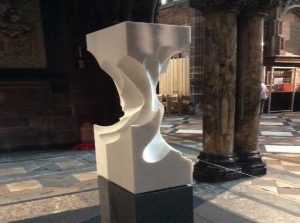
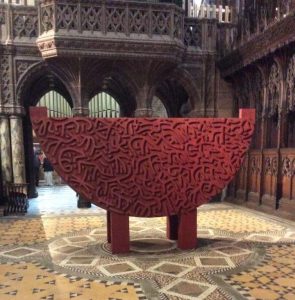
It was interesting to realise that looking at the temporary exhibition made one more aware of the skill and beauty of the resident misericords, bench ends and decorated arches.
A fascinating morning shared with many families and visitors who might not have gone to a gallery to see modern art but possibly lured in by ‘Percival’ 2006 by Sarah Lukas b1962, were really enjoying walking around with their maps.
The City Walls Liz Tucker
Chester has a lot in common with York, where I went to school. Both are cities with a Roman history, a cathedral, a castle on a hill, a racecourse, and extensive city walls. The most obvious difference is in the geology; Chester’s castle, cathedral and walls are all constructed of the bright red local sandstone.
The Romans first built a turf wall in about 75AD, around the important fortress of Deva, called after the local “goddess river”, now the Dee, which rushes down from Wales. Later, the wall was rebuilt in stone, and then repaired using old gravestones, now in the Grosvenor Museum. (You can see parts of the old Roman stones by leaning over the edge – we took their word for it!)
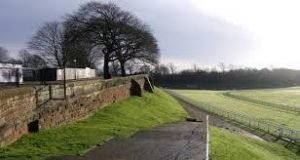
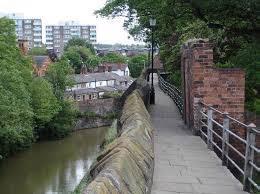
In Saxon times, Queen Aethelfleda extended the walls to the south and west, to protect her town (burh). They were maintained by officials known as murengers. Over the centuries, to the present day, the walls were fortified in the Civil War, gates were replaced by arches and bridges built, to accommodate increasing traffic, and towers were constructed. However, it is still possible to walk almost a complete circuit, reminiscent of the playing-card shape of the Roman fort.
Among the towers are King Charles’ Tower, from which the king could see his defeated army straggling back from the Battle of Rowton Moor; the Parlour, a semi-circular tower from which an official watched his employees making rope in the street below; and the Water Tower, where goods were unloaded from the River Dee in medieval times. The picturesque river is celebrated in the poem “O Mary, call the cattle home, across the sands of Dee” and the song about the Jolly Miller who “cares for nobody, no, not I, and nobody cares for me”.
Later the river silted up, and was canalised in the 18th century; around the same time, the Chester Canal was constructed, now part of the Shropshire Union Canal.
I was surprised to see that many stretches of the wall are actually at street level on the inside, which I have never noticed before in any walled city. On the outside, there are dramatic views down to the Dee, with its historic bridge, and to the canal. We could see boats and barges, and were sorry we did not have time for a boat trip, which we usually do on HADAS trips!
ROMAN CHESTER Andy Simpson
HADAS chums will know of my distinct weakness for all things Romano-British, so a day to explore Chester –the former legionary fortress of Deva Victrix, home of Legio XX Valeria Victrix – for Roman relics old and new was a definite bonus! The most obvious feature is of course the Roman parts of the city walls, especially the stretch of north wall with 13 rather bulging un-mortared courses of wall with its original Roman Cornice overlooking the canal.
Leaving the group at the cathedral, first stop was the group of Roman column bases and stone-cut drainage channels and other fragments displayed on Northgate Street near the town hall.
After a diversion to check out the site of the former Chester tram depot (of which more in a later report) it was down to the half-exposed and comprehensively excavated amphitheatre (original capacity 8,000) with its well-illustrated and informative caption boards, a feature of many of the other sites visited during the day.
And onwards to part of the original Roman Eastgate arch visible from conveniently placed steps up to the top of the city wall on the north side over Dinky Donuts. Not quite up to Lincoln Newport arch standards, but good to see nonetheless.
Staying with the fast food theme, next up was a visit to the cellar of Spud-U- Like at 39 Bridge Street to view an impressive, and beautifully lit, section of legionary bathhouse stone hypocaust pillars; this section of hypocaust, which had supported the floor of the sudatarium (sweating Room) was discovered as early as 1821. Much of the bathhouse, with walls still standing 12 feet high, was wantonly destroyed by construction of the Grosvenor Shopping Mall on the east side of Bridge Street in 1963-4, with the developers permitting little archaeological salvage or recording.
Heading back towards the amphitheatre, the Roman Gardens by the Newgate, off Pepper Street, form a nice walk down to the River Dee and have more excellent caption boards and many of the columns and column bases from the exercise hall of the legionary baths salvaged by the Victorians when it was exposed in the 1860s, as well as a reconstructed section of hypocaust. Nearby is the base of a Roman angle tower beside the Newgate.
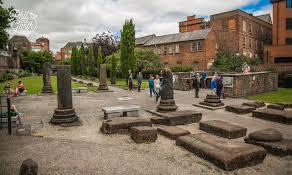
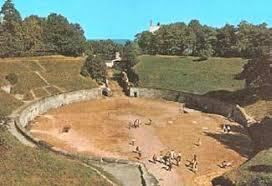
And, of course, the obligatory visit to the Grosvenor Museum (first opened in 1886) for its magnificent collection of Roman tombstones, sculptures and inscriptions, many of them some of the 150 or more found by the Victorians built into the city wall. These are displayed in the Graham Webster gallery – older readers will remember he was a former curator at the museum, expert on the Roman Army and long-time excavator at Wroxeter.
Locations with Roman remains not visited on this occasion included a section of hypocaust in 12 Northgate Street and column bases from the Principia in the cellar of Pret a Manger at 23 Northgate Row West, and also the strongroom of the Principia adjacent to the Dublin Packet pub on Northgate St. There is also the Dewa Roman experience with exposed Roman remains, just west of Bridge Street, and parts of the Roman quayside near the racecourse.
A handy pocket guide to these attractions is the booklet ‘Deva – Roman Chester – Discover Chester’s Ancient Ruins’ by Gordon Emery – published 2017 – a snip for just £2.95. So I know which bits to look out for on my next visit!
See http://roman-britain.co.uk/places/deva.htm and http://www.cheshirenow.co.uk/roman_chester.html and also
http://www.british-history.ac.uk/vch/ches/vol5/pt1/pp9-15
The London Mithraeum Stewart Wild
Roman Londinium’s Temple of Mithras, constructed around AD 240, was first discovered in 1954 during the excavation of a WWII bomb site prior to the building of Bucklersbury House in Walbrook, just north of Cannon Street. Lead archaeologist W. F. Grimes said of the discovery, “It was something of a fluke.”
Public interest was astonishing: some 30,000 people queued to see the excavation as it neared its conclusion. As a result, a partial reconstruction of the temple was unveiled in 1962 on Queen Victoria Street at street level roughly 300 feet northwest of its original location. There it resided for almost fifty years, increasingly ignored as modern buildings went up all around.
In 2010 American financial software and media giant Bloomberg acquired the triangular site for their European headquarters. The company worked with the City of London and a team of conservation specialists to excavate the entire site, recovering a wonderful hoard of Roman artefacts in the process. They agreed to dismantle the temple and reconstruct it close to its original position and level, recreating the form of the original foundation within a publicly accessible space.
Admission is free
Now, seven years on, members of the public can again admire the temple layout, seven metres below modern street level, in a purpose built air-conditioned vault. On the entrance level is a wall display of the astonishing variety of finds that were recovered during the year-long excavation.
Below on a mezzazine level are computer displays and information of the cult of Mithras across the Roman empire. Then you descend to the reconstructed low-level ruin itself, cleverly and atmospherically lit, and with suitable sound effects.
Known as Bloomberg SPACE, the London Mithraeum is open:
Tuesday – Saturday 10.00 – 18.00hrs Sundays 12.00 – 17.00hrs First Thursday of the month 10.00 – 20.00hrs
It’s best to book a timed ‘slot’ but walk-in visitors are welcome at off-peak times. Admission is free. The entrance is at 12 Walbrook, London EC4N 8AA. An average visit lasts between 60 and 90 minutes.
Future talk
On Tuesday 13 March 2018 the HADAS monthly meeting will feature a talk by Dr Roger Tomlin entitled Roman London’s First Voices: Roman writing tablets from Bloomberg, London. Don’t miss it.
Further information:
https://en.wikipedia.org/wiki/W._F._Grimes
https://www.londonmithraeum.com/visit/#book-your-visit
https://www.mola.org.uk/blog/archaeological-research-britain%E2%80%99s-oldest-hand-written-documents-released
LAMAS History Conference – Part 2 by Don Cooper
The morning session ended with the presentation of the 2017 Local History Publications Awards.
The Book prize was awarded to the Borough of Twickenham Local History Society for “Down the Drain” by Ray Elmitt. “Whetstone Revealed” by John Heathfield and David Berger, from the Friern Barnet and District Local History Society was Highly Commended
The Journal prize was awarded to Camden Local History for “Camden History Review number 40”, edited by David Hayes, described by the judging committee as outstanding.
The Newsletter prize (this was the first year this category has been awarded) was awarded to the Hornsey Historical Society for “newsletter 149”, edited by Lesley Ramm.
Newsletters 213, 214, 216, and 219 from the Barnes and Mortlake History Society, edited by Murray Hedgcock, were highly commended.
The first talk after lunch was by Julian Bowsher. It was entitled “Paratheatrical entertainment in 16th & 17th Century London”. Julian described the entertainments that took place other than plays in the theatre and other literary activities. These activities ranged from the legitimate ones: dancing, music, fencing matches, acrobatic displays and the exhibition of animals, to the illegitimate and unsavoury including such as: theft and gambling, prostitution and drunkenness. It was a good talk well illustrated. I must admit I hadn’t realised that fencing had been such a large sport in the 16th and 17th centuries.
Ian Bevan then took the same theme forward to the Victorians. Of course, by then there were parks and pleasure gardens, museums, art galleries, theatres, concert halls, music halls and organised sports such as rugby, and football all vying to provide entertainment outside the working day for a growing population, more affluent and ready and able to enjoy themselves.
Tea break brought the opportunity to visit the stalls of the many local history societies. There were lots of publications for sale. Many of them mentioned reducing membership and the difficulty in recruiting new younger active members. This is the same issue as plagues local archaeological societies. Perhaps 2018 will bring an opportunity for the consolidation of local heritage societies!
I was unable to attend the last two talks: Julie Ackroyd talk entitled “Stealing children in 1600: Stocking the London Stage with Actors” and Alexander Clayton’s talk on “Sapient Pigs and Rascal Tigers: Animal Curiosities on the Streets and Stages of London, C.1750-c.1850”.
Overall this conference on the “Pastimes in Times Past: entertainment in London” was enjoyable and successful.
The Curtain Playhouse excavations – lecture from excavator Heather Knight, Museum of London Sue Willetts
Excavation of this site by MoLA staff began in 2016 in response to earlier investigations related to a proposed redevelopment in Shoreditch (London Borough of Hackney) of an area of c.400,000 sq. ft. This excavation has greatly expanded our knowledge of 16th and 17th century theatre history and there have been some surprising discoveries. A drawing of the area now in Utrecht shows a polygonal theatre type building in the area and it was thought (erroneously) that this showed the Curtain Playhouse which we know was named after the nearby Curtain Close. The name Curtain is not connected to stage curtains, but related to the name of the walled pasture in which the playhouse was built.
Documentary evidence shows that the playhouse was open by 1577, but after it closed c.1625 it was demolished, and the site was lost. Records show that it was purpose built and used by Shakespeare’s company, The Lord Chamberlain’s men between 1597 and 1599 before they relocated to the newly built polygonal shaped Globe Playhouse on Bankside. The MoLA team were expecting to excavate a similar polygonal structure and although about ¼ of the building still lies beneath a pub there was enough archaeology left to show that the building was rectangular. The external dimensions were 25m x 22m and there was an open gravel yard where most of the audience would have stood, and while there is evidence of timber galleries with mid and upper areas, these may have been areas for standing. The eastern range housed a rectangular stage (c.14m x 5m) which was almost certainly used for fencing training / displays which fits in very well with the reach needed for two fencers on a stage. Another interesting feature of the Curtain Playhouse was the discovery of a passageway running underneath the stage with steps down to it from both ends to assist the movement of the actors.
Finds have included the lower part of a ceramic bird whistle which might have been used to create bird sounds, as in Romeo and Juliet, Act 3, Scene 5. Over 250 glass beads were found, which may have been from clothes worn by actors or by the audience. If from the latter this may indicate that productions at the Curtain were not (as had been suggested) mainly aimed at the lower end of the market. Other finds include finials from boxes used to collect money, (box office payment / money for food and drink) drinking vessels, clay pipes, fruit seeds and important dating evidence from two coins of 1572 and a James I farthing from 1613. It is thought that the Curtain Playhouse would have been able to hold an audience of 1400 in contrast to the nearby Curtain Theatre which would have been limited to about 800. It was pleasing to hear that the excavated area will be preserved in the new housing / retail development which is appropriately to be called The Stage.
For more information and images of finds, including the bird whistle, the finials and photographs of the excavations see the following websites:
http://www.mola.org.uk/blog/stage-set-shakespeares-curtain-theatre. The developer’s website shows how they propose to preserve and incorporate the excavated areas including a visitor centre.
http://www.thestageshoreditch.com/archaeology
This was an excellent lecture, shedding more light on the theatres and playhouses of Shakespearian London.
Other Societies’ events Eric Morgan
Friday, 19th January 7pm. COLAS, St. Olaves Parish Church, Mark Lane, EC3R 7BR.” Tower Bridge – The Bridgehouse Estates”. Talk by Dirk Bennett. Visitors £3.
Wednesday, 24th January 7.45pm. Friern Barnet& District Local History Society, North Middlesex Golf Club, The Manor House, Friern Barnet Lane, N20 0NL. “Life before Death – Stories from the Parish Churchyard”. Talk by John Phillpot. Visitors £2.
Thursday 1st February 8pm. Pinner Local History Society, Village Hall, Chapel Lane Car Park, Pinner, HA5 1AD. “The Denham Murders of 1870”. Talk by Neil Watson. Visitors £3.
Thursday 8th February 7.30pm. Camden History Society, Burgh House, New End Square, Hampstead, NW3 1LT. “Belsize remembered”. Talk by Ranee Bar. Visitors £1.
Monday, 12th February 3pm. Barnet Museum & Local History Society, Church House, Wood St. Barnet. “Zeppelin Raids of WW1” Talk by Harvey Watson. Visitors £2.
Wednesday, 14th February 2.30pm. Mill Hill Historical Society, Trinity Church, The Broadway, NW7. “The History of Pantomime”. Talk by Leanne Walters.
Wednesday, 14th February 7.45pm. Hornsey Historical Society, Union Church Hall, cnr Ferme Park Rd/Western Park, N8 9PX. “Evacuees of WW11”. Talk by Mike Brown. Visitors £2.
Wednesday, 21st February 7.30pm. Willesden Local History Society, St. Mary’s Church Hall, Neasden Lane, NW10 2TS. “Bankers & Fat Cats – exploring the lives of the well-off buried in Kensal Green Cemetery”. Talk by Signe Hoffos (COLAS)
Wednesday, 25th February 7.45pm. Friern Barnet& District Local History Society, North Middlesex Golf Club, The Manor House, Friern Barnet Lane, N20 0NL. “The History of Alms Houses”. Talk by Simon Smith. Visitors £2.
Early Notice
Saturday, 10th March. LAMAS 55th Annual Conference of London Archaeologists, The Weston Theatre, Museum of London.
The morning session is on recent excavation work in London
The afternoon session is on the Bloomberg Site (Temple of Mithras)
Early bird tickets £15 (if before the 1st March) from Jon Cotton, c/o Early Department, Museum of London, 150 London Wall, EC2Y 5HN. Enclose a stamped, self-addressed envelope. Cheques made payable to LAMAS.
Acknowledgements & Thanks: Jim Nelhams, Liz Tucker, Eric Morgan, Stewart Wild, Don Cooper, Audrey Hooson, Sue Willetts, Simon Williams, Sylvia Javes.
HADAS
Chairman: Don Cooper, 59 Potters Road, Barnet, EN5 5HS Tel: 020 8440 4350
Email: chairman@hadas.org.uk
Hon. Secretary: Jo Nelhams, 61 Potters Road, Barnet, EN5 5HS Tel: 020 8449 7076
Email: secretary@hadas.org.uk
Hon. Treasurer: Jim Nelhams, 61 Potters Road, Barnet, EN5 5HS Tel: 020 8449 7076
Email: treasurer@hadas.org.uk
Hon. Membership Sec. Stephen Brunning, 1 Reddings Close, Mill Hill, NW7 4JL Tel. 020 8959 6419
Email: membership@hadas.org.uk
Web site: www.hadas.org.uk/
Discussion group: http://groups.google.com/group/hadas-archaeology


